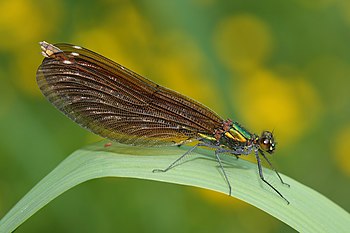Talk:Beautiful demoiselle
| This article is rated Start-class on Wikipedia's content assessment scale. It is of interest to the following WikiProjects: | |||||||||||
| |||||||||||
Merging[edit]
Why. There is enough information for both articles. Look at the article in the German wikipedia, and you understand what I mean. Taka 18:03, 29 August 2006 (UTC)
- I agree - there is no good reason to merge the genus and species articles! Kaarel 00:05, 7 September 2006 (UTC)
I agree too Dixonsej
File:Beautiful Demoiselle Calopteryx virgo.jpg to appear as POTD soon[edit]
Hello! This is a note to let the editors of this article know that File:Beautiful Demoiselle Calopteryx virgo.jpg will be appearing as picture of the day on July 18, 2012. You can view and edit the POTD blurb at Template:POTD/2012-07-18. If this article needs any attention or maintenance, it would be preferable if that could be done before its appearance on the Main Page so Wikipedia doesn't look bad. :) Thanks! —howcheng {chat} 17:54, 16 July 2012 (UTC)
Hello! This is a note to let the editors of this article know that File:ColapteryxVirgo.jpg will be appearing as picture of the day on March 31, 2014. You can view and edit the POTD blurb at Template:POTD/2014-03-31. If this article needs any attention or maintenance, it would be preferable if that could be done before its appearance on the Main Page. Thanks! — Crisco 1492 (talk) 00:47, 13 March 2014 (UTC)
Englishing needed[edit]
The following passage is too opaque to edit: "the severity of the tracheal gills on their abdomen. Compared to other damselflies Demoiselles larvae fall immediately on the other hand, due to their much shorter mean gill lamella." --Wetman (talk) 01:59, 31 March 2014 (UTC)
- Eight years later, the opacity remains. I've made a start copy editing the Conservation section, and will continue as time allows. Just plain Bill (talk) 14:56, 9 March 2022 (UTC)
- Many sentences in the article seem almost deliberately damaged, not just the one mentioned. Parts of sentences are repeated or shifted to points where their connection to the rest isn’t understandable. If large parts of the article were translated by online services, the reader needs to be warned about that, but I don’t think the problems I see would result from online translation.
- This pretty animal seems predestined to appear as picture of the day. But three times?
- Walter Turner 2003:E4:FF0C:5577:BCF9:837E:67:4876 (talk) 08:54, 17 February 2023 (UTC)



